Preoperative Education Report: Strategies for Patient Education
VerifiedAdded on 2022/08/31
|5
|1013
|18
Report
AI Summary
This report focuses on the significance of preoperative education for patients undergoing the Hartmann’s procedure, emphasizing its role in enhancing patient satisfaction and postoperative management. It outlines crucial topics for patient education, including potential surgical complications, bowel function, lifestyle adjustments, and stoma care. The report details the Hartmann’s procedure, its implications, and potential complications. Strategies for effective patient education are discussed, such as using plain language with visuals and incorporating eHealth technology to support patient understanding and self-management. The teach-back method is highlighted as a key tool for assessing patient comprehension and ensuring adherence to medical advice, thereby improving patient outcomes. The report references several studies and resources to support the importance of preoperative education.
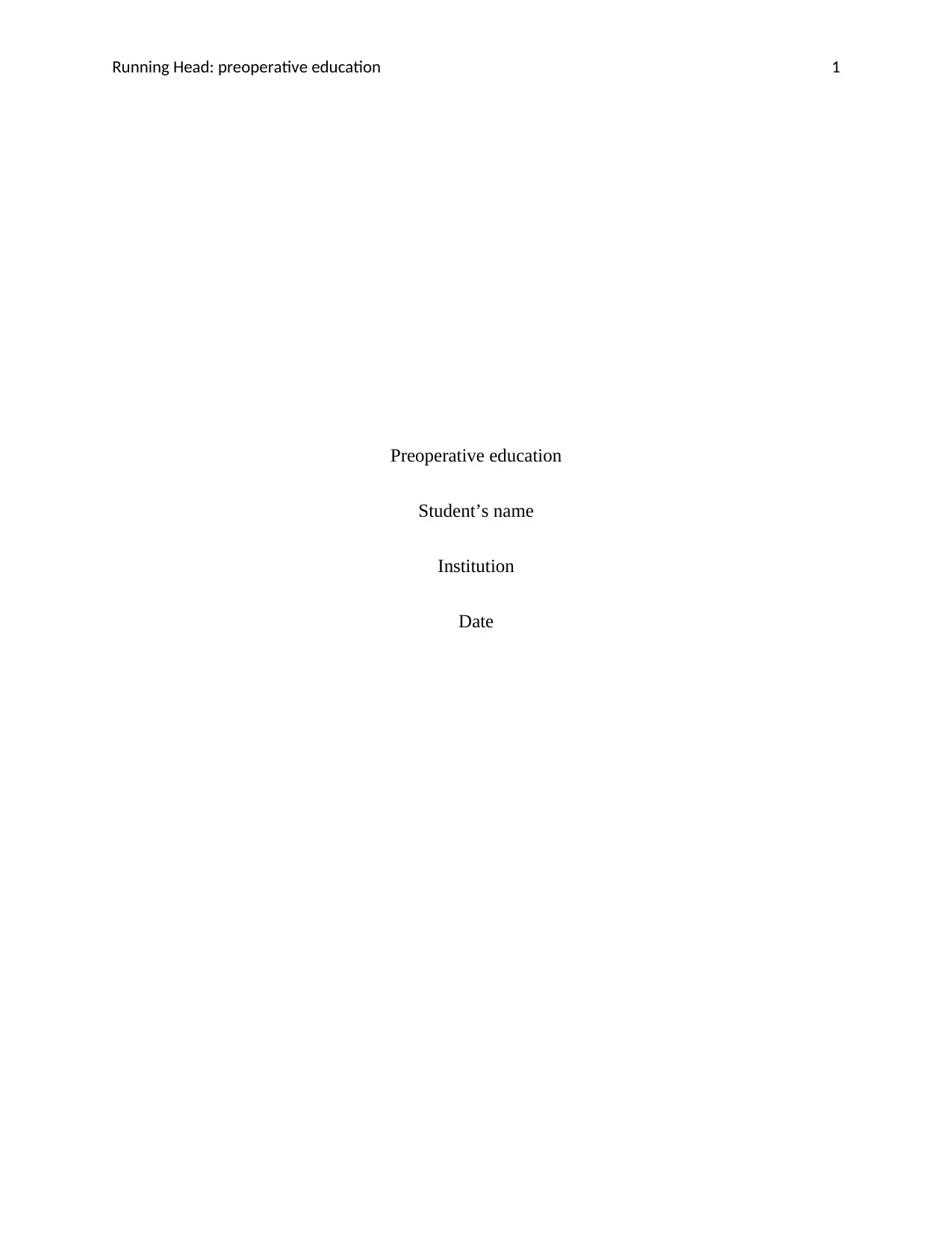
Running Head: preoperative education 1
Preoperative education
Student’s name
Institution
Date
Preoperative education
Student’s name
Institution
Date
Paraphrase This Document
Need a fresh take? Get an instant paraphrase of this document with our AI Paraphraser
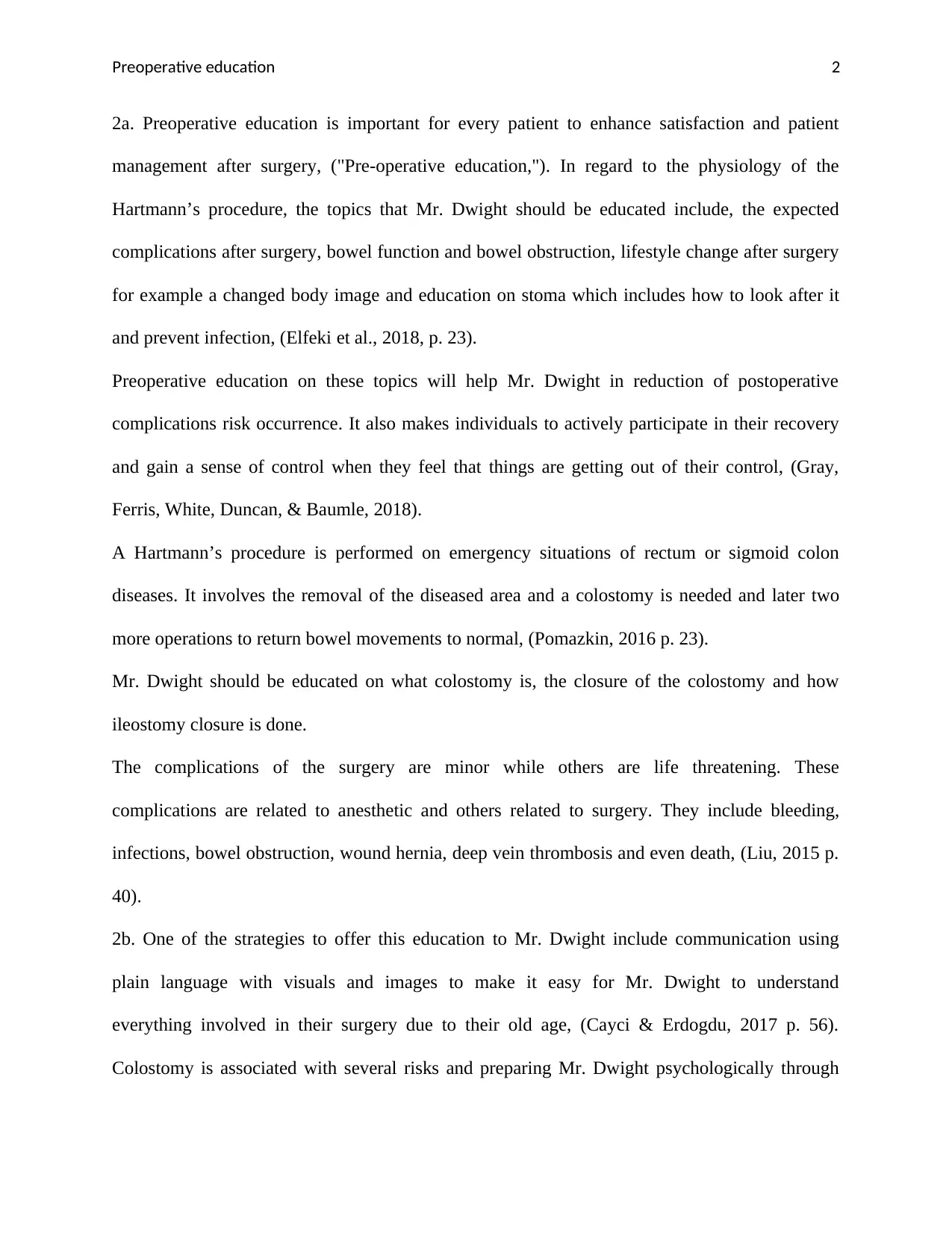
Preoperative education 2
2a. Preoperative education is important for every patient to enhance satisfaction and patient
management after surgery, ("Pre-operative education,"). In regard to the physiology of the
Hartmann’s procedure, the topics that Mr. Dwight should be educated include, the expected
complications after surgery, bowel function and bowel obstruction, lifestyle change after surgery
for example a changed body image and education on stoma which includes how to look after it
and prevent infection, (Elfeki et al., 2018, p. 23).
Preoperative education on these topics will help Mr. Dwight in reduction of postoperative
complications risk occurrence. It also makes individuals to actively participate in their recovery
and gain a sense of control when they feel that things are getting out of their control, (Gray,
Ferris, White, Duncan, & Baumle, 2018).
A Hartmann’s procedure is performed on emergency situations of rectum or sigmoid colon
diseases. It involves the removal of the diseased area and a colostomy is needed and later two
more operations to return bowel movements to normal, (Pomazkin, 2016 p. 23).
Mr. Dwight should be educated on what colostomy is, the closure of the colostomy and how
ileostomy closure is done.
The complications of the surgery are minor while others are life threatening. These
complications are related to anesthetic and others related to surgery. They include bleeding,
infections, bowel obstruction, wound hernia, deep vein thrombosis and even death, (Liu, 2015 p.
40).
2b. One of the strategies to offer this education to Mr. Dwight include communication using
plain language with visuals and images to make it easy for Mr. Dwight to understand
everything involved in their surgery due to their old age, (Cayci & Erdogdu, 2017 p. 56).
Colostomy is associated with several risks and preparing Mr. Dwight psychologically through
2a. Preoperative education is important for every patient to enhance satisfaction and patient
management after surgery, ("Pre-operative education,"). In regard to the physiology of the
Hartmann’s procedure, the topics that Mr. Dwight should be educated include, the expected
complications after surgery, bowel function and bowel obstruction, lifestyle change after surgery
for example a changed body image and education on stoma which includes how to look after it
and prevent infection, (Elfeki et al., 2018, p. 23).
Preoperative education on these topics will help Mr. Dwight in reduction of postoperative
complications risk occurrence. It also makes individuals to actively participate in their recovery
and gain a sense of control when they feel that things are getting out of their control, (Gray,
Ferris, White, Duncan, & Baumle, 2018).
A Hartmann’s procedure is performed on emergency situations of rectum or sigmoid colon
diseases. It involves the removal of the diseased area and a colostomy is needed and later two
more operations to return bowel movements to normal, (Pomazkin, 2016 p. 23).
Mr. Dwight should be educated on what colostomy is, the closure of the colostomy and how
ileostomy closure is done.
The complications of the surgery are minor while others are life threatening. These
complications are related to anesthetic and others related to surgery. They include bleeding,
infections, bowel obstruction, wound hernia, deep vein thrombosis and even death, (Liu, 2015 p.
40).
2b. One of the strategies to offer this education to Mr. Dwight include communication using
plain language with visuals and images to make it easy for Mr. Dwight to understand
everything involved in their surgery due to their old age, (Cayci & Erdogdu, 2017 p. 56).
Colostomy is associated with several risks and preparing Mr. Dwight psychologically through
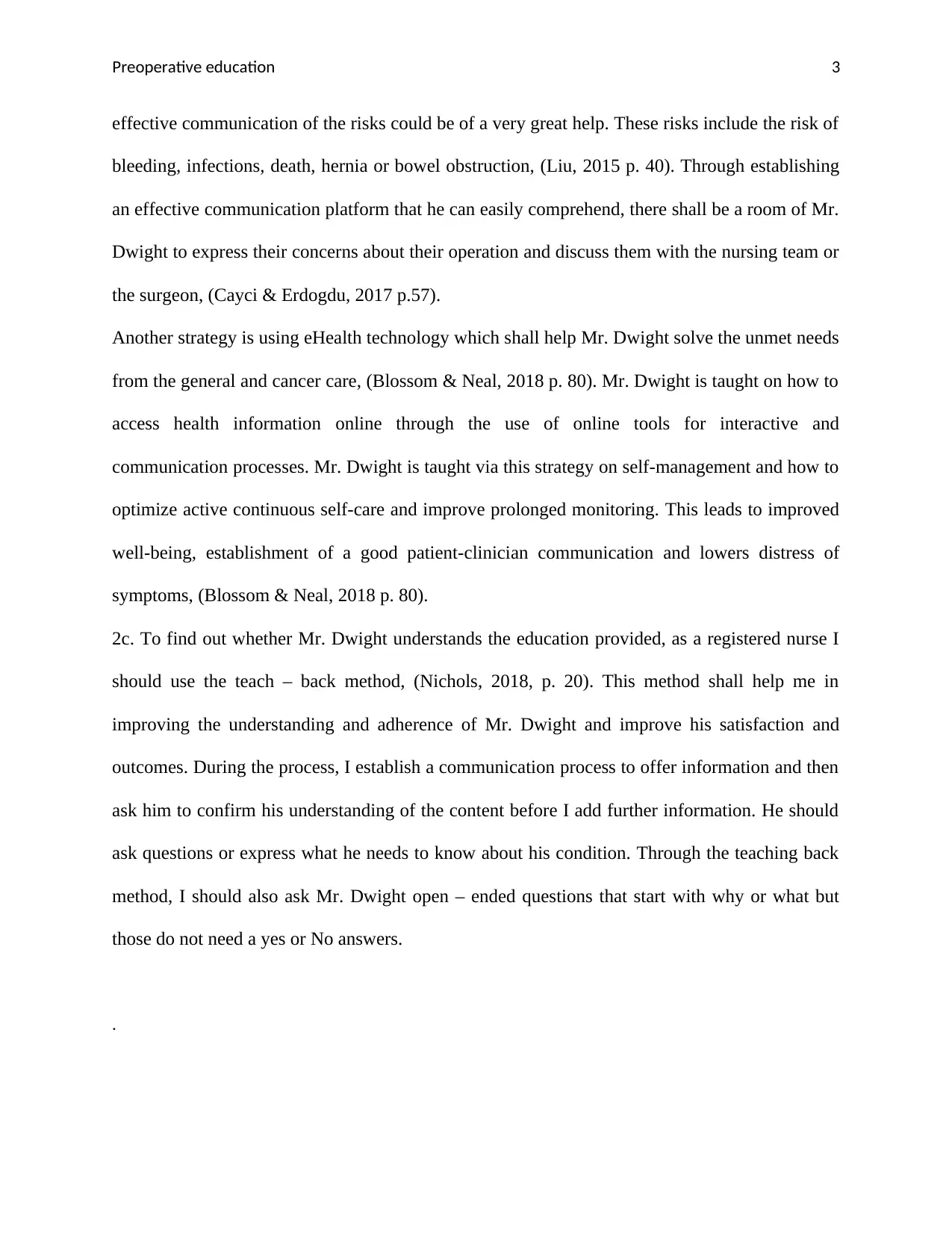
Preoperative education 3
effective communication of the risks could be of a very great help. These risks include the risk of
bleeding, infections, death, hernia or bowel obstruction, (Liu, 2015 p. 40). Through establishing
an effective communication platform that he can easily comprehend, there shall be a room of Mr.
Dwight to express their concerns about their operation and discuss them with the nursing team or
the surgeon, (Cayci & Erdogdu, 2017 p.57).
Another strategy is using eHealth technology which shall help Mr. Dwight solve the unmet needs
from the general and cancer care, (Blossom & Neal, 2018 p. 80). Mr. Dwight is taught on how to
access health information online through the use of online tools for interactive and
communication processes. Mr. Dwight is taught via this strategy on self-management and how to
optimize active continuous self-care and improve prolonged monitoring. This leads to improved
well-being, establishment of a good patient-clinician communication and lowers distress of
symptoms, (Blossom & Neal, 2018 p. 80).
2c. To find out whether Mr. Dwight understands the education provided, as a registered nurse I
should use the teach – back method, (Nichols, 2018, p. 20). This method shall help me in
improving the understanding and adherence of Mr. Dwight and improve his satisfaction and
outcomes. During the process, I establish a communication process to offer information and then
ask him to confirm his understanding of the content before I add further information. He should
ask questions or express what he needs to know about his condition. Through the teaching back
method, I should also ask Mr. Dwight open – ended questions that start with why or what but
those do not need a yes or No answers.
.
effective communication of the risks could be of a very great help. These risks include the risk of
bleeding, infections, death, hernia or bowel obstruction, (Liu, 2015 p. 40). Through establishing
an effective communication platform that he can easily comprehend, there shall be a room of Mr.
Dwight to express their concerns about their operation and discuss them with the nursing team or
the surgeon, (Cayci & Erdogdu, 2017 p.57).
Another strategy is using eHealth technology which shall help Mr. Dwight solve the unmet needs
from the general and cancer care, (Blossom & Neal, 2018 p. 80). Mr. Dwight is taught on how to
access health information online through the use of online tools for interactive and
communication processes. Mr. Dwight is taught via this strategy on self-management and how to
optimize active continuous self-care and improve prolonged monitoring. This leads to improved
well-being, establishment of a good patient-clinician communication and lowers distress of
symptoms, (Blossom & Neal, 2018 p. 80).
2c. To find out whether Mr. Dwight understands the education provided, as a registered nurse I
should use the teach – back method, (Nichols, 2018, p. 20). This method shall help me in
improving the understanding and adherence of Mr. Dwight and improve his satisfaction and
outcomes. During the process, I establish a communication process to offer information and then
ask him to confirm his understanding of the content before I add further information. He should
ask questions or express what he needs to know about his condition. Through the teaching back
method, I should also ask Mr. Dwight open – ended questions that start with why or what but
those do not need a yes or No answers.
.
⊘ This is a preview!⊘
Do you want full access?
Subscribe today to unlock all pages.

Trusted by 1+ million students worldwide
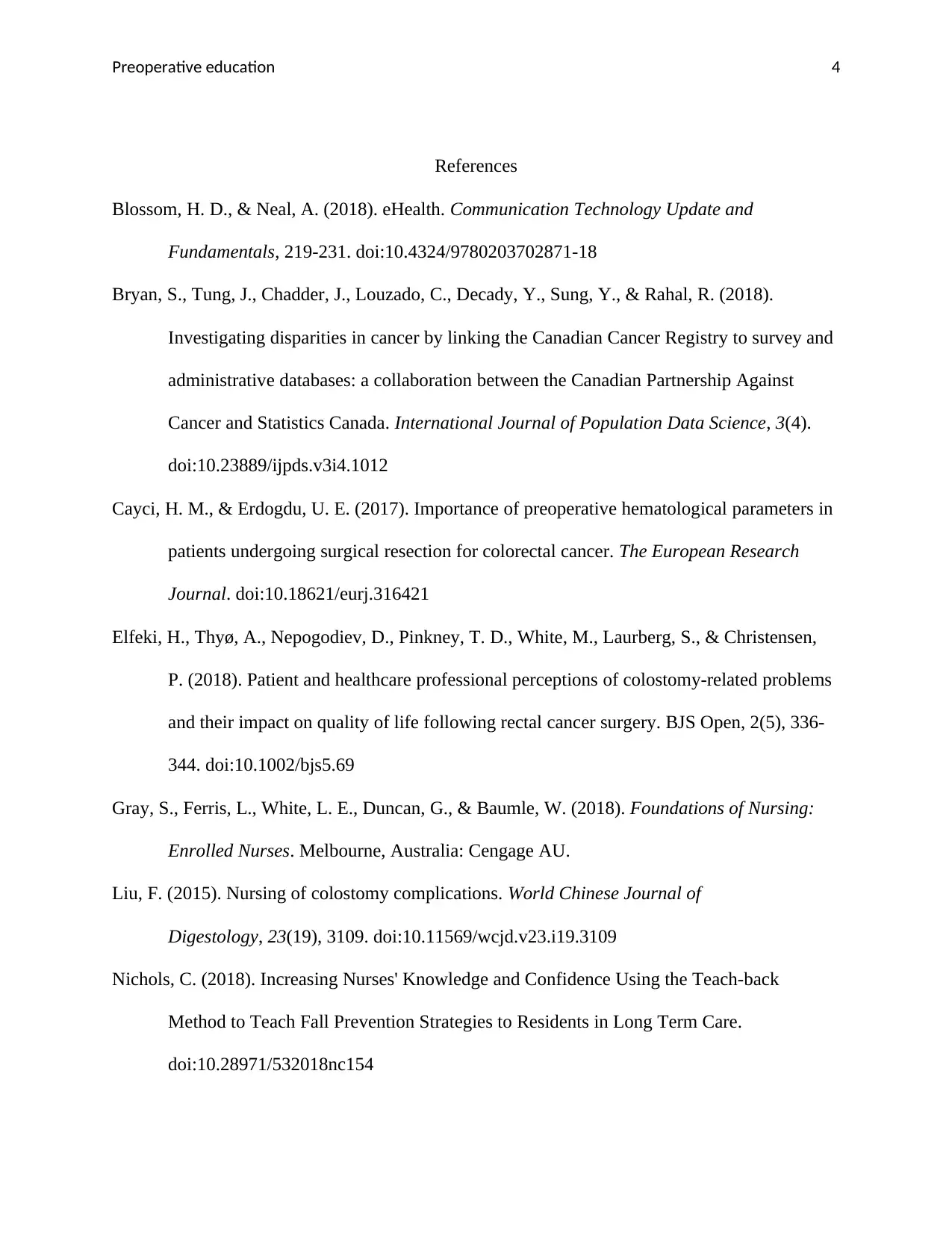
Preoperative education 4
References
Blossom, H. D., & Neal, A. (2018). eHealth. Communication Technology Update and
Fundamentals, 219-231. doi:10.4324/9780203702871-18
Bryan, S., Tung, J., Chadder, J., Louzado, C., Decady, Y., Sung, Y., & Rahal, R. (2018).
Investigating disparities in cancer by linking the Canadian Cancer Registry to survey and
administrative databases: a collaboration between the Canadian Partnership Against
Cancer and Statistics Canada. International Journal of Population Data Science, 3(4).
doi:10.23889/ijpds.v3i4.1012
Cayci, H. M., & Erdogdu, U. E. (2017). Importance of preoperative hematological parameters in
patients undergoing surgical resection for colorectal cancer. The European Research
Journal. doi:10.18621/eurj.316421
Elfeki, H., Thyø, A., Nepogodiev, D., Pinkney, T. D., White, M., Laurberg, S., & Christensen,
P. (2018). Patient and healthcare professional perceptions of colostomy-related problems
and their impact on quality of life following rectal cancer surgery. BJS Open, 2(5), 336-
344. doi:10.1002/bjs5.69
Gray, S., Ferris, L., White, L. E., Duncan, G., & Baumle, W. (2018). Foundations of Nursing:
Enrolled Nurses. Melbourne, Australia: Cengage AU.
Liu, F. (2015). Nursing of colostomy complications. World Chinese Journal of
Digestology, 23(19), 3109. doi:10.11569/wcjd.v23.i19.3109
Nichols, C. (2018). Increasing Nurses' Knowledge and Confidence Using the Teach-back
Method to Teach Fall Prevention Strategies to Residents in Long Term Care.
doi:10.28971/532018nc154
References
Blossom, H. D., & Neal, A. (2018). eHealth. Communication Technology Update and
Fundamentals, 219-231. doi:10.4324/9780203702871-18
Bryan, S., Tung, J., Chadder, J., Louzado, C., Decady, Y., Sung, Y., & Rahal, R. (2018).
Investigating disparities in cancer by linking the Canadian Cancer Registry to survey and
administrative databases: a collaboration between the Canadian Partnership Against
Cancer and Statistics Canada. International Journal of Population Data Science, 3(4).
doi:10.23889/ijpds.v3i4.1012
Cayci, H. M., & Erdogdu, U. E. (2017). Importance of preoperative hematological parameters in
patients undergoing surgical resection for colorectal cancer. The European Research
Journal. doi:10.18621/eurj.316421
Elfeki, H., Thyø, A., Nepogodiev, D., Pinkney, T. D., White, M., Laurberg, S., & Christensen,
P. (2018). Patient and healthcare professional perceptions of colostomy-related problems
and their impact on quality of life following rectal cancer surgery. BJS Open, 2(5), 336-
344. doi:10.1002/bjs5.69
Gray, S., Ferris, L., White, L. E., Duncan, G., & Baumle, W. (2018). Foundations of Nursing:
Enrolled Nurses. Melbourne, Australia: Cengage AU.
Liu, F. (2015). Nursing of colostomy complications. World Chinese Journal of
Digestology, 23(19), 3109. doi:10.11569/wcjd.v23.i19.3109
Nichols, C. (2018). Increasing Nurses' Knowledge and Confidence Using the Teach-back
Method to Teach Fall Prevention Strategies to Residents in Long Term Care.
doi:10.28971/532018nc154
Paraphrase This Document
Need a fresh take? Get an instant paraphrase of this document with our AI Paraphraser
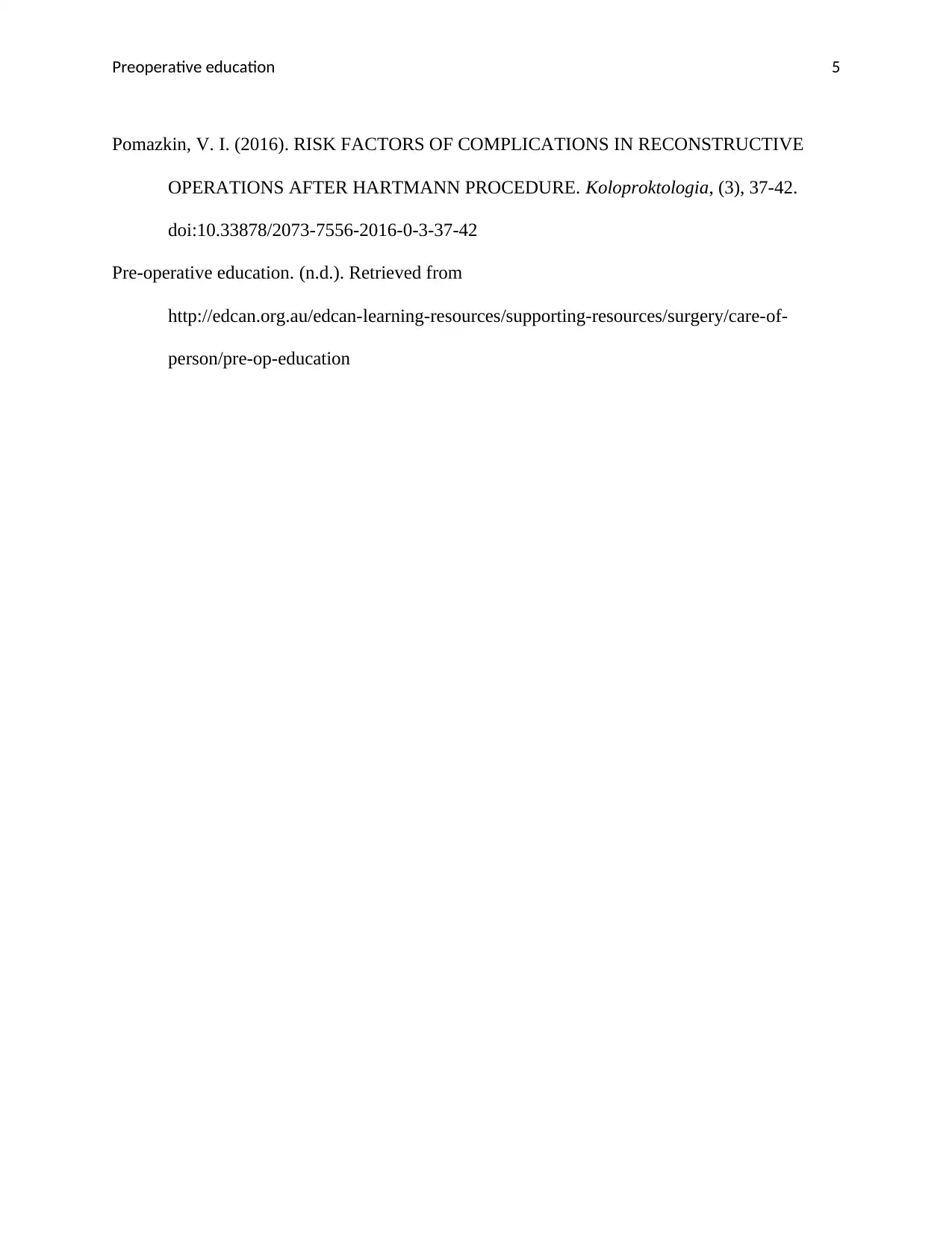
Preoperative education 5
Pomazkin, V. I. (2016). RISK FACTORS OF COMPLICATIONS IN RECONSTRUCTIVE
OPERATIONS AFTER HARTMANN PROCEDURE. Koloproktologia, (3), 37-42.
doi:10.33878/2073-7556-2016-0-3-37-42
Pre-operative education. (n.d.). Retrieved from
http://edcan.org.au/edcan-learning-resources/supporting-resources/surgery/care-of-
person/pre-op-education
Pomazkin, V. I. (2016). RISK FACTORS OF COMPLICATIONS IN RECONSTRUCTIVE
OPERATIONS AFTER HARTMANN PROCEDURE. Koloproktologia, (3), 37-42.
doi:10.33878/2073-7556-2016-0-3-37-42
Pre-operative education. (n.d.). Retrieved from
http://edcan.org.au/edcan-learning-resources/supporting-resources/surgery/care-of-
person/pre-op-education
1 out of 5
Your All-in-One AI-Powered Toolkit for Academic Success.
+13062052269
info@desklib.com
Available 24*7 on WhatsApp / Email
![[object Object]](/_next/static/media/star-bottom.7253800d.svg)
Unlock your academic potential
Copyright © 2020–2025 A2Z Services. All Rights Reserved. Developed and managed by ZUCOL.